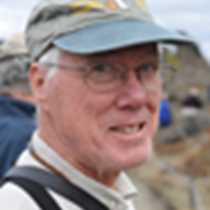Cape Lookout, Elephant Island, Antarctica
During the evening we passed through the Antarctic Convergence to enter the cold, nutrient-rich waters of the Antarctic. We had been told to expect a visible change in biological diversity; little could we have guessed! All morning, as we made our way southward toward Elephant Island, our ship was surrounded by the blows of large baleen whales – humpbacks, fins, and seis busily feeding. A krill layer could be seen on our ship’s sonar beginning at a depth of about 20 meters, and the whales were busily exploiting it to restore the layer of blubber that was depleted during the past Austral winter. Once the waters around Antarctica teemed with whales, but they were reduced to near-extinction by 20th century whalers, first from shore-based whaling stations, later from giant floating factories. Population recovery has been slow, so this abundance of whales was a gratifying and hopeful sight, even as some nations push for a restoration of commercial whaling.
Land came into view, the ice-covered peaks of Elephant Island. Soon the first iceberg was spotted. As we neared our destination National Geographic author and traveler Kim Heacox told the remarkable story of Ernest Shackleton and the Imperial Transantarctic Expedition of 1914-16. With perfect timing, we passed Point Wild where 22 men waited anxiously as Shackleton and five others made the incredible small boat journey to South Georgia Island, 800 miles across the Southern Ocean, to bring rescue.
And then came our first Antarctic landing. We boarded our fleet of Zodiacs to reach a rocky beach at Cape Lookout. We were greeted by a committee of chinstrap and gentoo penguins. One comic-serious macaroni penguin, its golden plumes blowing in the wind, made its way past, no doubt returning with a belly full of food for its single chick waiting none-too-patiently. We made our way along a rocky path created by the passage of countless penguin feet to reach the main breeding colonies, gentoo penguins on flatter land just above the beach, chinstraps on the rocky slope above. The cacophony of calling penguins was punctuated by occasional loud belches, sneezes, and snorts coming from a pile of huge elephant seals lying in a pungent wallow. The seals have completed their breeding activities for the season; they are now stuck on land as they molt, changing their fur coat for the coming winter. But not so the penguins; they have growing, ever-demanding chicks to be fed. There is a constant coming and going at a penguin colony as birds returning from a feeding trip clamber over the rocks, greet their mate, and transfer food to the young. We could scarcely take in all of the sights, sounds, and smells of our first visit to an Antarctic penguin colony – what we have come all this distance to experience. Already, it was well worth it, and we have more to come!
During the evening we passed through the Antarctic Convergence to enter the cold, nutrient-rich waters of the Antarctic. We had been told to expect a visible change in biological diversity; little could we have guessed! All morning, as we made our way southward toward Elephant Island, our ship was surrounded by the blows of large baleen whales – humpbacks, fins, and seis busily feeding. A krill layer could be seen on our ship’s sonar beginning at a depth of about 20 meters, and the whales were busily exploiting it to restore the layer of blubber that was depleted during the past Austral winter. Once the waters around Antarctica teemed with whales, but they were reduced to near-extinction by 20th century whalers, first from shore-based whaling stations, later from giant floating factories. Population recovery has been slow, so this abundance of whales was a gratifying and hopeful sight, even as some nations push for a restoration of commercial whaling.
Land came into view, the ice-covered peaks of Elephant Island. Soon the first iceberg was spotted. As we neared our destination National Geographic author and traveler Kim Heacox told the remarkable story of Ernest Shackleton and the Imperial Transantarctic Expedition of 1914-16. With perfect timing, we passed Point Wild where 22 men waited anxiously as Shackleton and five others made the incredible small boat journey to South Georgia Island, 800 miles across the Southern Ocean, to bring rescue.
And then came our first Antarctic landing. We boarded our fleet of Zodiacs to reach a rocky beach at Cape Lookout. We were greeted by a committee of chinstrap and gentoo penguins. One comic-serious macaroni penguin, its golden plumes blowing in the wind, made its way past, no doubt returning with a belly full of food for its single chick waiting none-too-patiently. We made our way along a rocky path created by the passage of countless penguin feet to reach the main breeding colonies, gentoo penguins on flatter land just above the beach, chinstraps on the rocky slope above. The cacophony of calling penguins was punctuated by occasional loud belches, sneezes, and snorts coming from a pile of huge elephant seals lying in a pungent wallow. The seals have completed their breeding activities for the season; they are now stuck on land as they molt, changing their fur coat for the coming winter. But not so the penguins; they have growing, ever-demanding chicks to be fed. There is a constant coming and going at a penguin colony as birds returning from a feeding trip clamber over the rocks, greet their mate, and transfer food to the young. We could scarcely take in all of the sights, sounds, and smells of our first visit to an Antarctic penguin colony – what we have come all this distance to experience. Already, it was well worth it, and we have more to come!




